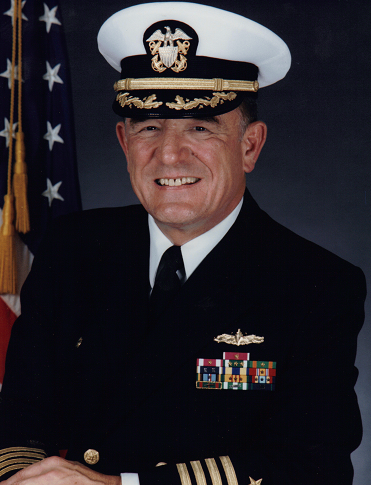From One Great Communicator to Another
It sounds like it’s straight out of a novel — or bigger, a movie on the big screen.
This is the powerful story California State University, Northridge alumnus and Navy Capt. (ret.) William Dallas Bethea ’69 (History) shared with past and current crew, former and current commanding officers and a group of others at Naval Base San Diego on July 23, 2015, at the decommissioning of the USS Gary, a naval warship that was in service for 31 years:
The way the Boys of Gary engaged the Silkworm missile that came roaring in on us at the speed of sound, 30 to 50 feet off the water, heavily armed with a 1,100-pound high explosive warhead, is the proudest memory of my naval career. While the executive officer counted down the decreasing range of the inbound missile over the ship’s loudspeaker system — 40 miles, 35, 30, 25, 20, 15, 10 — those boys quietly and professionally did everything that needed to be done, everything they had been trained to do.
The Combat Information Center was as quiet as a surgical ward, and the bridge was the same. From the radar operators, to the electronic warfare system operators, to the gun and missile system crews, to the engineers and communications team, no one panicked and they all functioned like a well-oiled machine. It was the epitome of pure teamwork.
If that missile attack had succeeded, a great majority of us would have been killed instantly, and there were seven Iranian fighter-bombers waiting just outside Gary’s missile envelope, poised to attack the mobile sea bases we were protecting. The casualties would have been in the hundreds. Minutes after the missile attack failed, the Iranian fighters returned to base, unwilling to take on a single ship — unwilling to [take] on USS Gary, who had a bone in her teeth and they knew it.
Bethea was the ship’s second commanding officer, serving from 1986-89. He had a decorated naval career, which included command of two warships and service in Vietnam and the Persian Gulf. Bethea also worked at the Pentagon from 1983-85. In 1998, after 32 years, he retired from the Navy and moved to Virginia, where the 70-year-old lives today.
Bethea’s communication skills and precision helped him succeed in the military and motivate people. He said those skills were developed at what was then San Fernando Valley State College and honed by CSUN history professor James E. Sefton.
The impact was so deep that Bethea decided to endow a scholarship in Sefton’s name at CSUN. “Dr. Sefton means a lot to me,” Bethea said. “He was one of my mentors at Valley State.”
Bethea remembered taking 21 units of classes with Sefton. In the professor, he explained, he found someone who could challenge him and build his knowledge. Bethea recalled taking Sefton’s class on the Civil War and having numerous back-and-forth debates with him.
The classes and Sefton helped Bethea later in life because he learned the art of precision, he said. And that back-and-forth helped him learn how to communicate and lead.
“There’s a lot of human judgment that goes into the military when you’re dealing with subordinates,” he said. “You have to appreciate what they’re thinking and experiencing from their side. I learned that at Valley State College. [Studying] history made me learn there are many different sides to an issue.”
In 2013, CSUN’s Department of History honored Bethea with its inaugural Distinguished Alumni Award. In his acceptance speech, he acknowledged just how much Sefton meant to him. So, when CSUN honored Sefton in 2015 for his 50 years of teaching at the university, Bethea didn’t hesitate to hop on a plane in support of his beloved professor.
Then he took it a step further. For the man and school that helped shape his career, Bethea endowed a scholarship in the name of Sefton.
“I wanted to do it before he retires, as a tribute to him,” Bethea said. “I just want to give back, and I really feel this is the best way I can do it. … I really wanted to help history students out, and I hope it’s awarded to people with the same love [of history].
“CSUN was the college that gave me the opportunity to expand my horizons and be the person I am now,” he continued. “I learned how to write, how to think critically. It was an incredible experience.”


 experience
experience